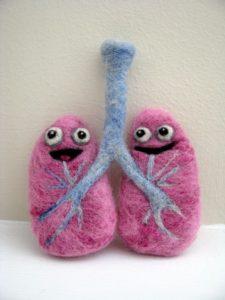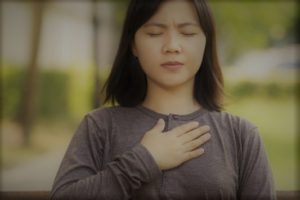 This post is not meant to replace medical advice. Download a PDF version of this post here.
This post is not meant to replace medical advice. Download a PDF version of this post here.
Mindful breathing can be part of calming (easing agitation), grounding (physically connecting to Earth or becoming consciously aware of physical connection to floor, chair etc.), and centering (bringing attention into focus).
Not everyone can take slow or deep breaths, including those dealing with things like: Asthma, COPD, Emphysema, Tuberculosis (TB), Cancers, Reflux/Stomach Disease, Bronchitis, Respiratory Virus, Pneumonia, Heart Conditions, Palliative/End of Life, Cystic Fibrosis, Neurological Conditions, Autoimmune Conditions, Smoking.
Breathing may be difficult because of:
- Weak muscles, fatigue, muscle spasms, or lack of muscle movement.
- Inability to breathe out fully (“bad air” gets trapped in lungs) so breathing in deeply is impossible.
- Other organs, tumours, fluid, inflammation may affect lungs.
Short, rapid breathing is called hyperventilation:
- Reduced oxygen affects cognition, mood, memory, energy, coordination, sleep.
- The heart races in response to shallow breathing, which triggers more anxiety.
A reasonable goal may be to slow the breathing to calm the person, even if they cannot deepen their breathing. Sometimes this starts with focusing on the breath. Self-talk, visualization, or other approaches may help too. Everyone has different needs, preferences, and abilities.
Guidelines for Activities and Exercises
No Discomfort or Harm: Always let people know that they should not do anything that causes pain or makes breathing more difficult or uncomfortable. Agree on a way that to signal discomfort or a need to stop the exercise.
Adaptations: Explore specific changes that make an exercise suitable for each individual, (always with help and consultation from their health care providers). Being attuned to the need for adaptations and practicing adapting exercises promotes body awareness and regulation, and can help decrease stressful experiences of struggling.
Alternate Positioning: Invite the person to choose whether they are most comfortable standing, sitting up straight, reclining, or lying down.
Breathing Together: Some people are most comfortable doing breathing exercises while being held or supported by another person, or they may benefit just from having someone with them who is calm and grounded and centered. Breathing together promotes co-regulation, for those who may not be able to self-regulate well. (Co-regulation will be familiar for those who work with infants and small children, because it is an essential part of early development).
Information Sources: The Lung Association, Kelowna General Hospital Respiratory Services, Others
 Breathing Exercises
Breathing Exercises
Take a Break:
- Breathe however you are able – don’t try to deepen your breath.
- Try taking a short rest (count for a few seconds) at the “bottom of the breath” (after the out breath).
- This exercise can help to slow breathing and is especially useful for laboured breathing – when the person is exhausted and/or struggling.
- Helpful in palliative settings or for anyone in respiratory distress.
Source: Pema Chodron: When Pain is the Doorway (audio)
Pursed Lip Breathing:
- Breathe in through the nose (or mouth), and out through pursed lips (or making a duck face works too!).
- This focuses the attention, and helps to slow the breath.
- Used for lung diseases, and anxiety or panic.
Source: KGH Respiratory Services
Bellows Breathing:
- Start with hands in “prayer pose” (hands facing upwards under chin) OR folded in lap.
- With the in breath, slowly separate hands outward to each side. Imagine that you are pushing against resistance to slow the movement.
- Bring hands back to centre with the out breath, again imagining that there is resistance against your movements. This exercise helps to center (focus) the mind and slow the breath.
- Appropriate for people with more muscle strength and agility but you can lessen the muscle movements (start with hands in lap) for those who need less exertion.
Source: CFTRE
 Butterfly Breathing (or Eagle, or Pterodactyl) – For Children:
Butterfly Breathing (or Eagle, or Pterodactyl) – For Children:
(pick your favourite winged creature)
Clasp hands under chin, and lift your arms up to form wings.
OR – Make wings with arms extended out at sides.
OR – Just use your hands, if arm movement is not possible.
Wiggle your wings to exercise them!
Now practice moving your wings slowly up and down.
Step 1: Breathe IN slowly as you raise your wings up
Step 2: Breathe OUT slowly as you lower your wings gently down
Source: NICABM, BC Children’s Hospital
Bonus: Get kids to show how other animals breathe. Prepare to have a good laugh.
Breathing techniques are sourced from Kelowna General Hospital Respiratory Services, National Institute for the Clinical Application of Behavioural Medicine, the teachings of Pema Chodron, and the Canadian Foundation for Trauma Research and Education.